
Collaborative Acute Aortic Syndrome Project

Considering Leading Expert's Antithrombotic Regimes after Peripheral Angioplasty

Covid-19 Vascular Service Study
The COVER study was a prospective international multicentre study funded by the NIHR, running from March 2020 to April 2022. It comprised three tiers:
Tier 1: Survey of 249 centres showing major global changes in vascular services, including higher thresholds for AAA and an endovascular-first approach to limb ischaemia.
Tier 2: Outcomes from 3,150 procedures at 69 centres revealed higher in-hospital and 6-month mortality across major vascular operations, strongly linked to COVID-19 infection.
Tier 3: Analysis of 1,801 patients found that 1 in 5 received altered care, often involving delays or non-surgical management.
Findings were published in BJS, Annals of Vascular Surgery, Annals of the RCS England, the Journal of Vascular Societies GB&I and EJVES Vascular Forum.

Diabetic Foot Debridement in Theatre
DEFINITE was an audit and prospective international multicentre cohort study that aimed to measure surgical diabetic foot infection practice evaluating global surgical practices for diabetic foot infections against IWGDF and GVG guidelines.
DEFINITE was conducted between December 2021 and September 2022. In total, data on 754 limbs from 753 patients who underwent surgical management of diabetic foot complications at 30 centres were included.
Data revealed significant variation in practice, particularly around pre-op antibiotics, WIfI risk stratification, intraoperative sampling, and post-op antibiotic use. At 90 days, only 35% of wounds had healed, while others required further intervention
Results were presented at VSASM 2023 and published in the British Journal of Surgery.

Frailty in Chronic Limb Threatening Ischaemia
A multicentre prospective observational study investigating the prevalence and short-term impact of frailty, anaemia, sarcopenia and multi-morbidity in chronic limb threatening ischaemia
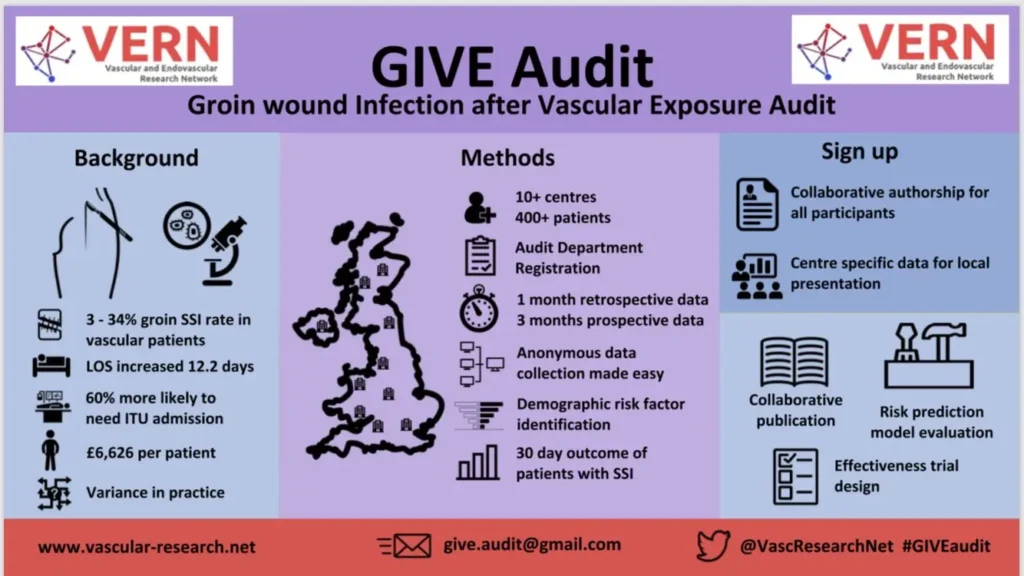
Groin wound Infection after Vascular Exposure Study
The Groin wound Infection after Vascular Exposure (GIVE) study was a prospective international cohort study (Jan–Aug 2019) investigating groin wound surgical site infection (SSI) rates, risk factors, and outcomes after arterial intervention.
Data from 1,337 groin incisions across 37 centres showed an 8.6% SSI rate, associated with longer hospital stay and higher risk of acute kidney injury. Significant variation in SSI prevention practices was observed. Risk factors included female sex, BMI, ischaemic heart disease, skin prep, conduit type, and operative time. New prediction models were developed and outperformed existing risk prediction models identified in a systematic search of the literature. Deprivation was not linked to SSI risk but identified that patients from deprived areas presented with similar levels of comorbidities at a younger age
Findings were presented at VSASM 2019 & 2020 and published in the International Wound Journal, EJVES, and Surgical Infections.
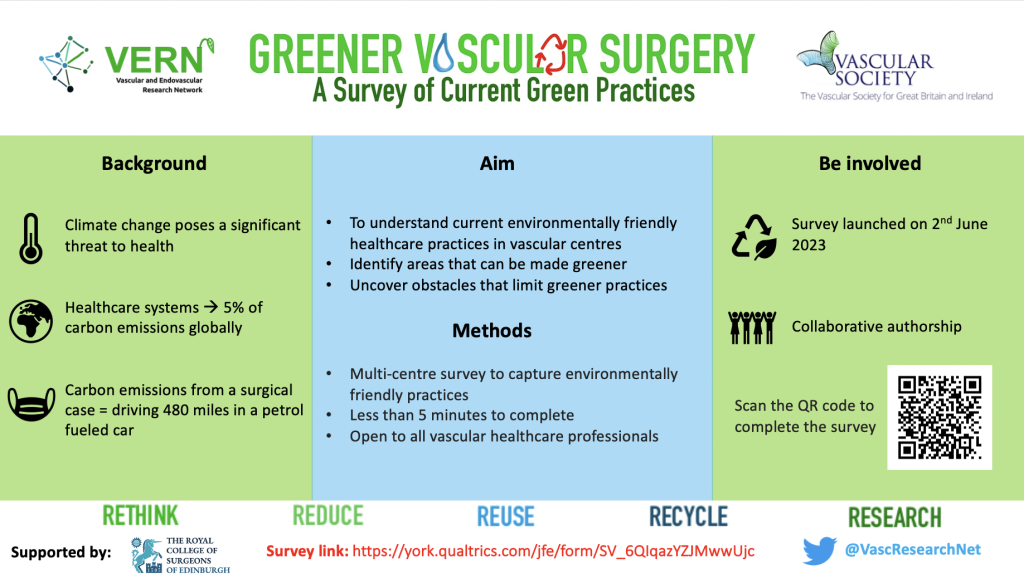
A Survey of Current Green Practices
Greener Vascular Surgery was a global survey led by VERN, VSGBI, and RCSEd SSB (June–Sept 2023) which aimed to understand the current green practices in vascular surgery centres.
Responses from 115 professionals across 14 countries revealed considerable variability in green practices across all surgical phases. Most respondents reported that environmental sustainability was never discussed in departmental meetings, and tools like the Intercollegiate Green Theatre Checklist were underused - though there was strong support for their adoption. Disposable materials were widely used, and most centres did not have measures in place to reduce water usage (such as pedal or automated taps for scrubbing). Most respondents welcomed further research and guidance to support greener theatre practices.
The study was presented at VSASM and published in the Annals of Vascular Surgery.
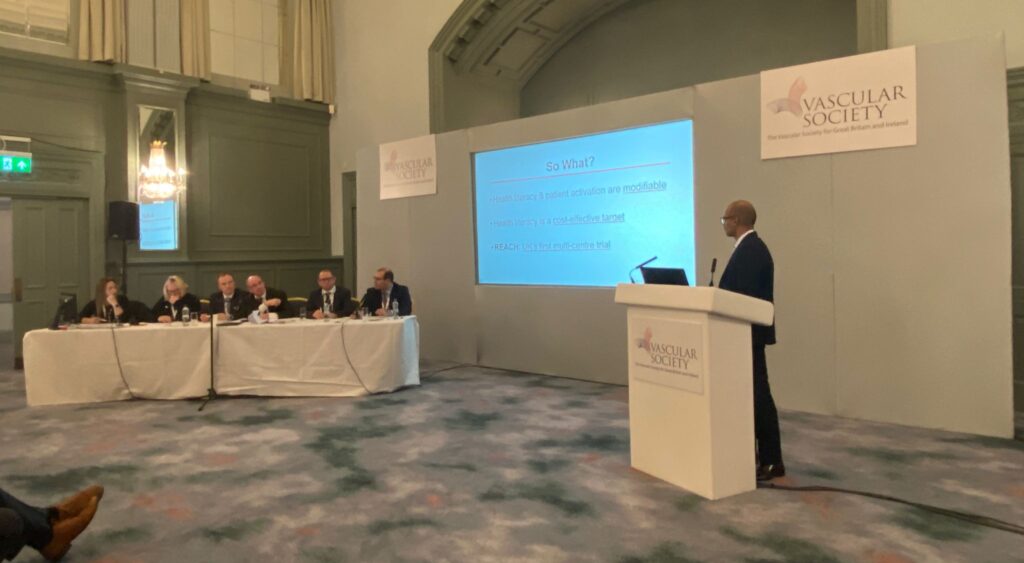
This was a prospective audit aiming to identify areas where practice for infrarenal endovascular aneurysm repair (EVAR) varied.
Utilising the Vascular and Endovascular Research Network (VERN), the audit was disseminated to vascular surgery centres within the UK. A total of 15 vascular surgery centres participated. The audit identified variability in several aspects of infrarenal EVAR – most centres did not perform day-case EVAR and performed cases under a general anaesthetic. There was variability in post-operative inpatient imaging to start post-EVAR surveillance, both in terms of timing and the modality used (duplex, plain x-ray, and computerised tomography).
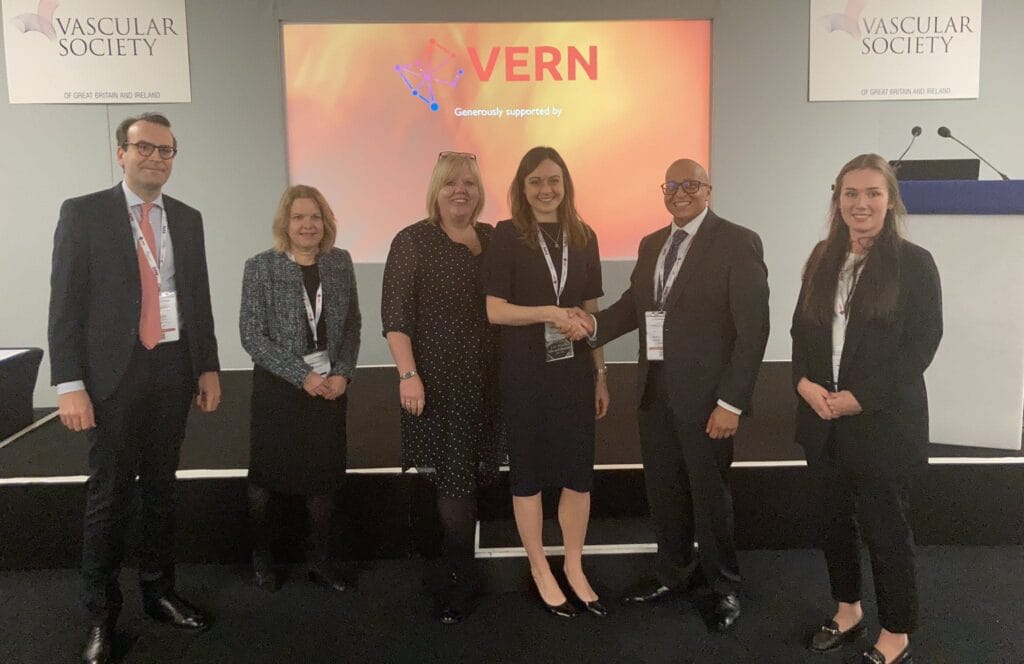
The Midlands Aortic Renal Injury study
The Midlands Aortic Renal Injury (MARI) study was a prospective national multicentre cohort study which aimed to report the impact of aortic intervention of post-operative renal function.
The study was awarded funding by the National Institute for Health Research Leicester Biomedical Research Centre and was conducted between September 2017 and December 2018. A total of 11 vascular surgery centres within the UK participated.
Data on 300 patients were included who underwent infrarenal EVAR, fEVAR, bEVAR, infrarenal open repair and juxtarenal open repair. The study demonstrated that acute kidney injury after aortic intervention was common and that the main predictors of acute kidney injury after infrarenal EVAR or open repair were older age, lower baseline renal function, and ischaemic heart disease.
The study has been published in the European Journal of Vascular and Endovascular Surgery.
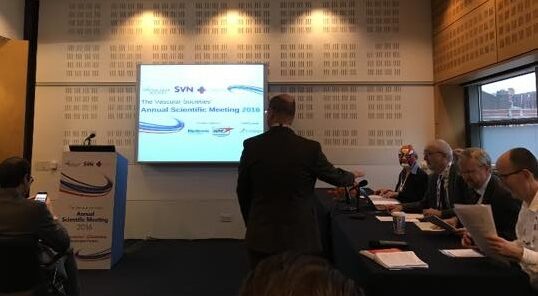
Observational study of the medical management of patients with peripheral arterial disease
This was a prospective multicentre cohort study that aimed to assess the cardiovascular profiles of patients with peripheral arterial disease (PAD), measure practice against the UK and European goal-directed best medical therapy guidelines.
A total of 440 consecutive patients with PAD from 10 UK vascular surgery centres were included. Whilst most patients were prescribed statin therapy, only 11.1% were receiving high-dose statin therapy. Over half of patients were not prescribed antiplatelet or anticoagulant therapy.
Utilising the SMART-REACH score, it was estimated that controlling all modifiable risk factors in accordance with NICE/ESC would confer a 29% absolute risk reduction in predicted 10-year cardiovascular events and a 6.3-year gain in cardiovascular event-free time.
The study has been published in the British Journal of Surgery

PrEdiction of Risk and Communication of outcomE following major lower limb amputation
PERCEIVE was a prospective international multicentre cohort study evaluating how accurately healthcare professionals and existing risk prediction tools forecast outcomes after major lower limb amputation (MLLA). The study assessed predictions for both 30-day and 1-year outcomes - mortality, revision, and ambulation.
Between October 2020 and May 2022, 38 centres (22 UK, 16 international) contributed data on 537 patients, generating 4,720 clinician predictions and validating 20 risk tools.
Findings showed clinicians predicted short-term mortality, MLLA revision, and long-term mortality more accurately than most risk tools. A combined model using clinician estimates improved short-term mortality prediction. However, predictions for short-term morbidity, long-term revision, and ambulation were less accurate.
Results were presented at VSASM 2021 & 2022 and published in the British Journal of Surgery and BJS Open

Vascular Interventions and Surgery in Trauma Audit
VISTA was a prospective international audit led by VERN and the Trauma and Audit Research Network (TARN), funded by the Circulation Foundation, aimed at evaluating the incidence, management, and outcomes of vascular trauma in the UK.
From March to October 2022, data were collected from 27 UK major trauma centres, covering 302 patients. Most injuries resulted from road traffic collisions, with two-thirds of patients undergoing surgery—71% open and 29% endovascular. Open procedures mainly addressed extremity trauma; endovascular techniques were mostly used for aortic injuries.
The study revealed a significant national burden of vascular trauma that is not captured by current registries like the NVR and suggests the need for expanded data collection to support quality improvement.
VISTA was presented at the Vascular Societies’ Annual Scientific Meeting in 2023.
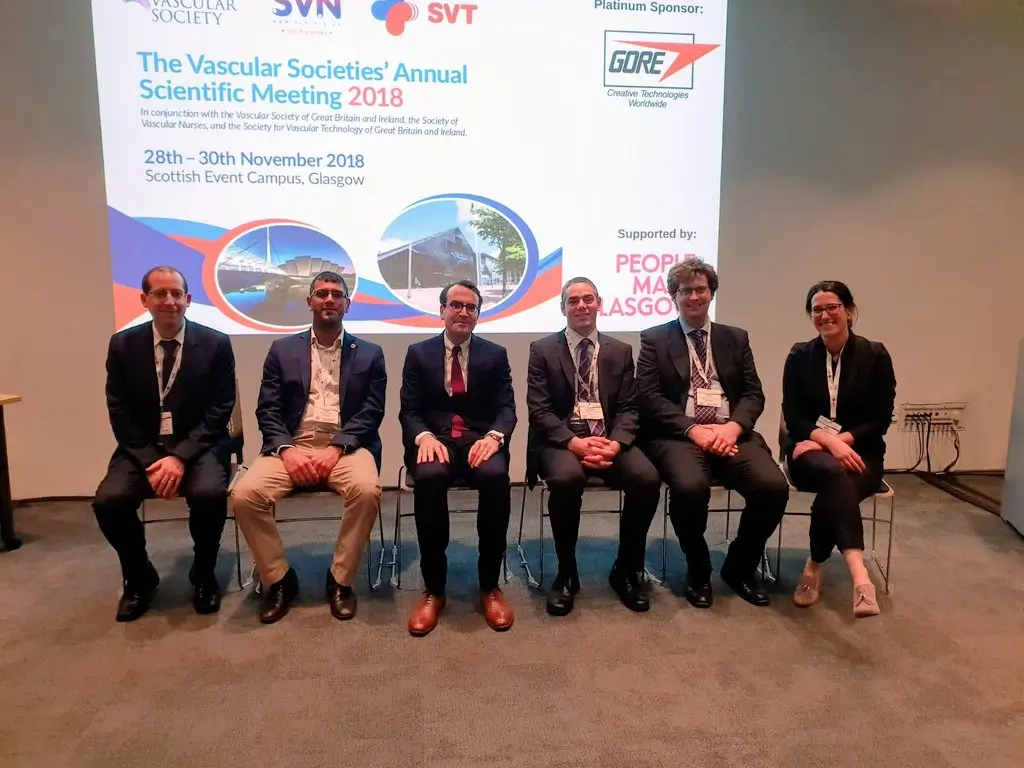
Reducing the risk of venous thromboembolism during superficial endovenous surgery: UK consensus study
This was a survey that aimed to report practice with regards to risk stratification and subsequent pharmacoprophylaxis preferences for venous thromboembolism and identify areas of consensus.
The survey was conducted between February 2017 and May 2019 using a modified Delphi consensus methodology. A total of 42 consultant vascular surgeons responses were included. Consultants perceived that a personal history of venous thromboembolism, inherited thrombophilia, and reduced mobility / impaired calf muscle pump function as the three most significant risk factors. There was considerable variability in practice preferences: most consultants utilised compression stockings (for varying duration) following intervention; the use of pharmacoprophylaxis most commonly included low molecular weight heparin but the duration of therapy varied from one perioperative dose to two weeks of therapy.
The survey results were published in Phlebology.
